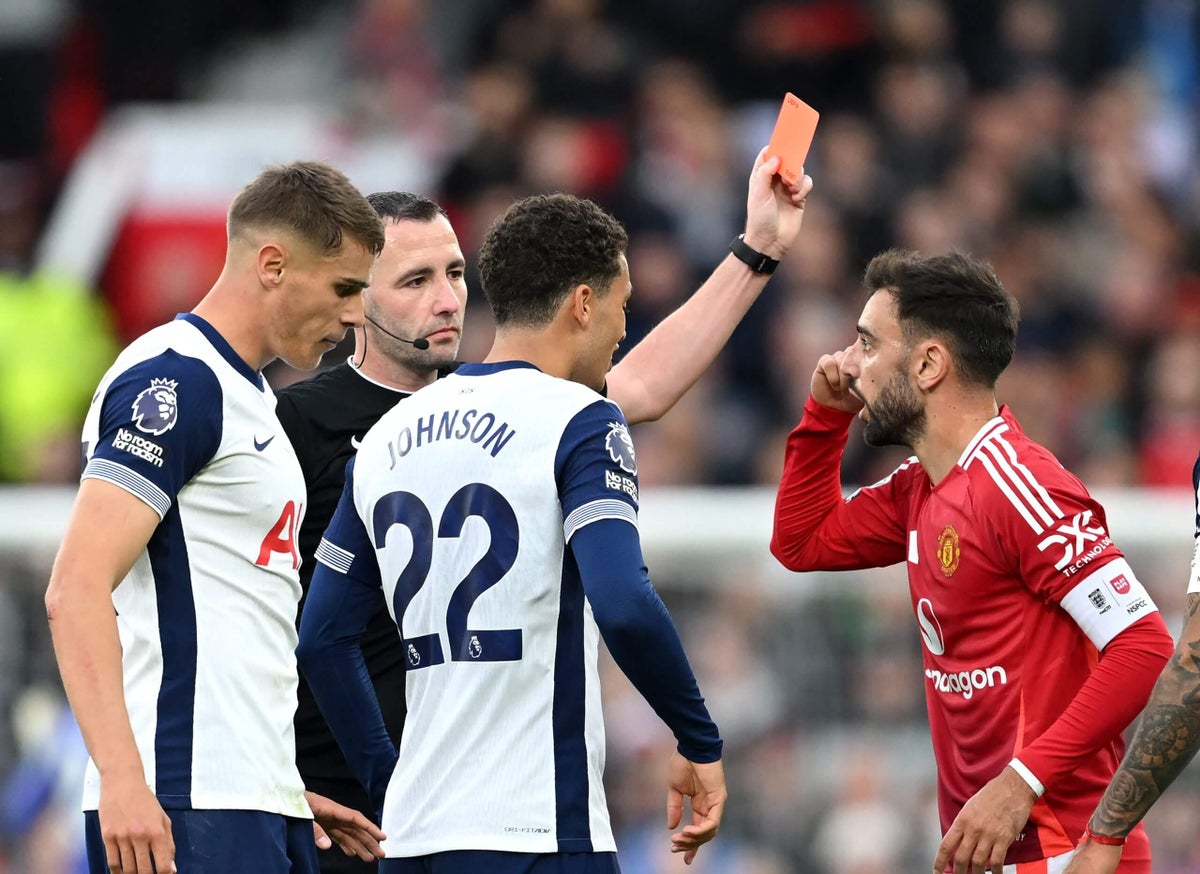English football’s refereeing chief Howard Webb says Bruno Fernandes’ incorrect red card against Tottenham Hotspur was not overturned on the day because the video assistant referee (VAR) mistakenly thought the decision did not meet the threshold for an on-field review.
Manchester United captain Fernandes was sent off late in the first half of his side’s 3-0 home defeat against Spurs on September 29, when his team were only 1-0 down, for a challenge on James Maddison, but United successfully appealed the decision and the red card was overturned.
The VAR audio from the fixture has now been released by Professional Game Match Officials Limited (PGMOL), English football’s professional refereeing body, on the Match Officials Mic’d Up show aired on Tuesday by UK broadcasters Sky Sports and TNT Sports.
The audio has an unidentified assistant referee (AR1 in the transcript below) initially informing referee Chris Kavanagh that Fernandes’ challenge is “100 per cent” a red card.
VAR Peter Bankes and assistant VAR Simon Long (AVAR in the transcript) then re-watch the incident from several angles, questioning how high the challenge is, whether Fernandes’ studs were used and whether there was any attempt to win the ball. Their conclusion is to stick with Kavanagh’s on-field decision of a dismissal for serious foul play.
According to PGMOL, fouls fall into the category of “subjective decisions”, meaning there has to be a clear and obvious error for the VAR to take action. But Webb, chief refereeing officer at PGMOL, explained that as Fernandes’ challenge did not involve excessive force and did not endanger Maddison, the on-field call was incorrect and that a pitchside review should have been recommended.
VAR audio transcript
AR1: That’s awful, that’s a red card for me. Red card, 100 per cent.
VAR: So, it’s a high foot, it’s not studs. It’s shin height. Does he rake down? It’s a deliberate act, he’s made no attempt to play the ball. The angle you’ll start seeing on broadcast doesn’t necessarily show it’s with studs.
AVAR: There is a slip but then there’s an action that makes contact with the shin.
VAR: I think ref’s call.
AVAR: Yeah.
VAR: Kav (addressing referee Kavanagh), I’m confirming the on-field decision of red card, serious foul play. Check complete.

(Michael Regan/Getty Images)
“Yes, it was (a mistake on the day),” Webb tells the show’s host, former England striker Michael Owen. “The red card was correctly overturned on appeal. We hear on the audio the assistant referee coming with the information around this being, from his position, a red-card offence and the referee takes his advice and issues the red.
“When you look back on the footage, you see that the contact is high and Bruno Fernandes slips first and puts his foot out to stop Maddison. It’s not an attempt for the ball, from the assistant referee’s position — he’s got a good view, a nice open view, a better viewing angle than what the referee has got — (it) looks like there are studs there going into the shin, and if there is it would be a red card, but it’s just a slight misread.
“When the VAR checks it, he forms the opinion that the ‘referee’s call’ is not clearly wrong because he sees the action with the high contact, no attempt to play the ball, with some force and therefore decides in his professional judgment that the ‘referee’s call’ is not clearly wrong.
“I think it is (wrong). I think, because it’s (with) the side of the foot, there’s absolutely no studs, there’s no driving the foot into the opponent, it’s more of a tripping action. There’s no excessive force, there’s no endangering the safety of Maddison.
“When you have the benefit of seeing this in the way we can here, we think this should have been an intervention. The VAR supported the on-field call — the referee’s call — and shouldn’t have done, and should have sent the referee to the screen to see this angle.”
Webb continues: “We’ve debriefed this, I’ve spoken to the VAR (Bankes). He accepts the referee’s call in this case was clearly wrong. In the moment he formed the opinion, it wasn’t at that threshold. This one was an error and the learning is taken from it. The key thing here is the contact doesn’t have excessive force and it doesn’t endanger the safety of the opponent, even though I understand why the on-field officials thought, in real time, it was.”
PGMOL guidelines state the VAR will intervene “if the evidence readily available from the broadcast footage shows that the referee’s on-field call is clearly and obviously wrong”.
Fernandes had his three-game suspension lifted after the Football Association (FA) upheld United’s claim of “wrongful dismissal”.
The FA handbook says a player is guilty of serious foul play if he “uses excessive force or brutality against an opponent when challenging for the ball when it is in play” or “a tackle that endangers the safety of an opponent must be sanctioned as serious foul play”.
(Top photo: Michael Regan/Getty Images)

